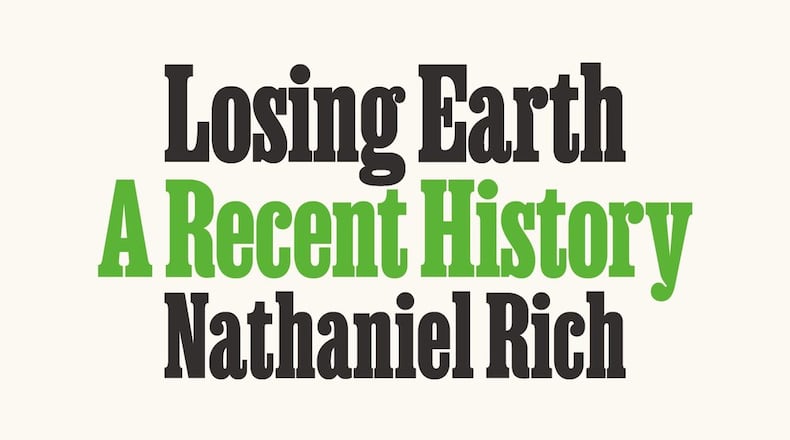One of the U.S. Congress' first House subcommittee hearings on the greenhouse effect and climate change was held almost 40 years ago, on July 31, 1981. In the book "Losing Earth," New Orleans-based author Nathaniel Rich discusses how such hearings tend to be stage-managed for maximum impact on the press and public, and how environmental and health issues tend to come equipped with heroes, victims and villains.
Rich quotes Tom Grumbly, staff director for then young congressman Al Gore, as being skeptical about the political value of holding a hearing for the greenhouse effect. “There are no villains,” Grumbly says. “Besides, who’s your victim?”
Gore answers, “If we don’t do something, we’re all going to be the victims.”
Reflecting on the subsequent decades of relative inaction, Rich pulls no punches in identifying villains and the long-term consequences of the victims, who tend to be all the inhabitants of a warming planet.
Subtitled “A Recent History,” “Losing Earth” dramatizes the increasingly dire findings in climate change research and the activism to minimize the effects of carbon emissions and global warming. Rich takes a unique perspective on the events by focusing on the science and politics of the issue from 1979 through 1989, arguing that we knew everything important then that we know now, but we squandered our first and best opportunities to address the problem.
“Losing Earth” originated as a 30,000-word magazine article that took up a full issue of The New York Times Magazine. Rich, the magazine’s writer-at-large, has expanded the article into a 200-page book that reads partly like an accessible history of recent events and partly like an impassioned polemic.
It isn’t meant to comfort the reader, and Rich’s introduction lays out the stakes: a rise in average global temperature of more than two degrees Celsius (which currently seems inevitable) promises devastating consequences, such as starvation, drought, abandonment of coastal cities and increasingly violent conflicts over decreasingly available resources.
The book’s two primary protagonists come across less as “heroes” than simply well-informed but ordinary people motivated to speak out. Rafe Pomerance is a tall, tweedy, emotionally demonstrative activist and lobbyist involved with groups such as Friends of the Earth. James Hansen is a calm, cool NASA atmospheric physicist who becomes one of the first and most outspoken researchers on the issue. But they’re just two in a large cast of characters involved with an issue that drew bipartisan concern, at least in its early years, from the likes of EPA administrator and establishment Republican William Reilly.
Much of the book follows the climate change issue over the decade as it wends its way through a maze of scientific, corporate and governmental organizations. If you’re not a policy wonk, it can require close reading to keep track of all the conferences, committees and institutes, and whether they have agendas beyond pure research. A glossary would have come in handy.
Fortunately, Rich has a novelist’s instinct for finding quirky, memorable details. One scientific conference takes place in a coastal hotel nicknamed “The Pink Palace,” which becomes a candy-colored backdrop as scientists try and fail to craft a strongly worded joint statement. “Losing Earth” offers brief tangents about such groups as The Jasons, a longstanding independent group of elite scientific advisers to the U.S. government.
At one point Pomerance and other activists watch jealously as the threat to the ozone layer in the mid-1980s steals the thunder from climate change: although a scientific misnomer, the “ozone hole” proved far more effective at inspiring chlorofluorocarbon (CFC) reduction than climate activism did in controlling carbon dioxide.
In the last quarter of the book, a colorful antagonist emerges in the person of John Sununu, the famously combative Chief of Staff of the Bush Administration, who effectively becomes the face of climate denialism of the time. Rich examines whether Sununu single-handedly torpedoed the 1989 Noordwijk conference’s attempt to establish a binding global treaty to limit greenhouse gases.
The author steps back to suggest the real villain may not be any one person, but a collective institutional resistance to accept short-term costs in favor of long-term benefits. Repeatedly the book shows politicians, oil industry executives and other influential figures voicing abstract concerns over climate change, only to walk back their statements the closer they get to actually doing something.
The book’s narrative is generally so strong that it leaves you wishing Rich brought similar research to bear on the subsequent decades, as the science grew more explicit, but climate denialism dug in even harder. It’s like the failed Noordwijk conference marks the end of the first act, but Act Two is confined to a 27-page afterword.
Rich’s righteous rhetoric, supported by a command of the facts, has a sharpness comparable to Thomas Paine’s pamphlets arguing the case for U.S. independence from England. His afterword in particular pulls no punches: “When a government relaxes regulations on coal-fired plants or erases scientific data from a federal website, it is guilty of more than merely bowing to corporate interests; it commits crimes against humanity.”
Losing Earth is not a book to be read at bedtime, assuming you don’t want to be stressed out over the globe’s fate while trying to sleep. Rich clearly wants to wake readers up.
NONFICTION
‘Losing Earth: A Recent History’
by Nathaniel Rich
Farrar, Straus and Giroux
206 pages, $25.
AUTHOR EVENT
Nathaniel Rich. 7 p.m., April 18. Free. The Carter Center, 453 Freedom Parkway, Atlanta. 404-420-5100. www.cartercenter.org
About the Author
Keep Reading
The Latest
Featured


